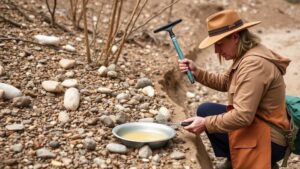How the Romans Mined Gold: Techniques From the Ancient World
How the Romans Mined Gold: Techniques From the Ancient World
The ancient Romans were renowned for their engineering prowess and resource management, particularly when it came to mining precious metals. Gold mining, in particular, facilitated the expansion of Roman wealth and power, influencing their economy and societal structure. This article explores the techniques employed by the Romans to mine gold, examining the tools, methods, and geography that contributed to their success.
The Geography of Roman Gold Mining
The Romans primarily mined gold in regions rich in mineral deposits. Key areas included:
- The Iberian Peninsula (modern-day Spain and Portugal), particularly in the provinces of Hispania Tarraconensis.
- The Alpes region, especially around the streams that flowed down from the mountains.
- The Dacia region, particularly after the conquest in AD 106, which provided significant resources from its gold mines.
These areas were strategically chosen not only for their mineral richness but also for their accessibility to Roman infrastructure, such as roads and ports.
Techniques of Extraction
The Romans employed a variety of techniques to extract gold from the earth, tailored to the geographical conditions and the nature of the gold deposits.
Placer Mining
One prevalent method was placer mining, where gold was extracted from riverbeds and alluvial deposits. Romans utilized simple tools such as pans and sluices to separate gold from sediment. This technique, akin to modern gold panning, relied on gravity to differentiate the heavier gold particles from lighter materials.
Hard Rock Mining
Also to placer mining, the Romans pioneered hard rock mining techniques. would dig deep shafts into the earth to reach gold veins. A notable innovation was the use of water-powered machinery, such as the waterwheel, to extract ore more efficiently. This technique is exemplified by the hydraulic mining methods used at the famous mines of Las Medulas in Spain, where water was diverted to erode the landscape, exposing the gold-laden gravel beneath.
Tunneling and Shaft Mining
For deeper mineral deposits, the Romans constructed extensive underground tunnels. deployed techniques similar to those used in contemporary mining, including:
- Cutting horizontal adits into hillsides to access gold deposits.
- Building vertical shafts to help transport ore to the surface.
These methods demonstrated advanced engineering capabilities, as they required precise calculations and a thorough understanding of geology.
Tools and Innovations
The Romans utilized various tools and innovations that facilitated gold mining, reflecting their technological advancements. Some notable tools included:
- The pickaxe for breaking rock.
- The hammer and chisel for detailed work in solid rock.
- Water wheels for creating hydraulic pressure to assist in moving large quantities of earth.
- Pans and sluices for easier collection of placer gold.
These tools exemplified the Romans’ adaptability and ingenuity in resource extraction.
Labor and Economic Impact
Gold mining was labor-intensive and often relied on slave labor and a workforce consisting of skilled miners. The implications of this labor force were profound:
- Gold mining significantly boosted Romes economy, with revenues supporting military campaigns and public works.
- It created a social hierarchy, where miners operated under harsh conditions for the enrichment of the elite.
By the first century AD, it was estimated that gold production peaked at about 20 tons per year from these mines, highlighting the importance of gold to the Roman economy.
Conclusion
The techniques employed by the Romans in gold mining were multifaceted, utilizing a combination of placer and hard rock mining methods, innovative tools, and a significant labor force. r success in gold extraction not only contributed to their immense wealth but also played a critical role in expanding their empire. Understanding these ancient techniques provides insight into the complexities of Roman society and the foundational role of mining in shaping their economic landscape.
For modern implications, the methods developed during Roman times laid groundwork for future mining practices. Insights from ancient techniques continue to influence contemporary mining technology and resource management strategies today.


